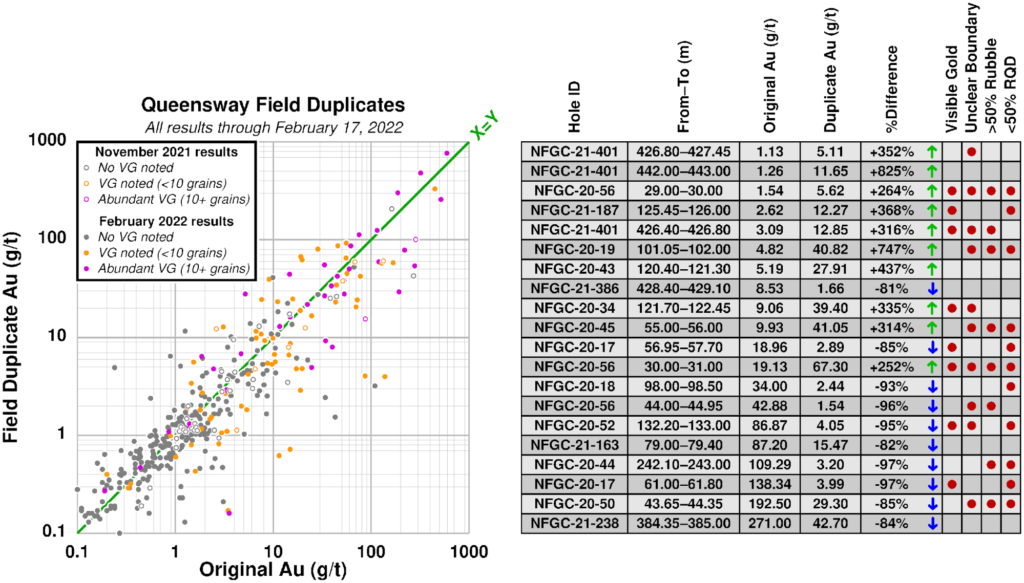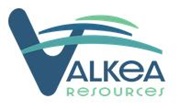New Found (NFG.V): Provides Results of QA/QC Review
Vancouver, BC, February 23, 2022 – New Found Gold Corp. (“New Found” or the “Company”) (TSX-V: NFG, NYSE-A: NFGC) is pleased to announce results of work programs and analysis completed by independent consultants initiated to investigate possible bias indicated by a set of 30 half-core duplicate assays (see Company’s November 4, 2021, news release). The work program included completion of a substantial number of additional half-core screen fire assays providing a data set of 475 half-core duplicates, and the detailed statistical assessment of these results. The work also included detailed review of sample selection, preparation, and lab analysis procedures for the screen fire assays at ALS Minerals (‘ALS’) in Vancouver, BC and Eastern Analytical (‘EA’) in Springdale, NL.
The investigative program was led by Lynda Bloom, M.Sc., P.Geo., a Toronto based consultant and recognized expert in sample process audits, QA/QC program design, and assay laboratory audits (see the Company’s December 15, 2021, news release), and Mo Srivastava, M.Sc., P.Geo., a recognized expert with more than 40 years’ experience in geostatistical analysis, author of “An Introduction to Applied Geostatistics”, a widely used textbook in geostatistics and of more than 50 technical articles on geostatistical theory and practice. He has taught geostatistics in public short courses and in university courses at Stanford, UBC, University of Toronto and Queen’s University and coordinated the development of standards and guidelines for the use of statistics and geostatistics for the ASTM and for the province of British Columbia.
Highlights
- New Found’s independent consultants have concluded that there is no evidence of systematic bias in the Company’s assay results.
- The consultants conclude that the project uses well conceived and documented standard operating procedures (SOPs) for marking and sawing core, and for selecting the half-core samples sent for analysis.
- The Company will now resume normal reporting of assay results.
- Mo Srivastava summarizes his findings as follows: “The field duplicate data from Queensway confirm that the very high natural in-situ variability creates potential for large differences in field duplicates in drill hole intervals with abundant visible gold. Although there are several intervals with striking differences, both positive and negative, these represent only a few percent of the several hundred field duplicates now available. A statistical comparison of all duplicate and original sample pairs, including the most variable, supports the view that the assays are accurate; the sampling procedures at site, and the preparation and analysis procedures at the lab, have not imparted any systematic bias to the reported gold grades.”
- Lynda Bloom of Analytical Solutions Ltd. summarizes her findings as follows: “Our rigorous review of the NFG assay quality control data did not identify any systematic accuracy or contamination issues at either ALS or EA. Over 12,000 samples have been assayed by the expensive screened metallic fire assay method on at least 3 kg of a half-core sample, demonstrating management’s efforts to manage sub-sampling issues inherent with high grade gold deposits. Throughout the extensive database there are examples of rare events where duplicate assays of the fine fraction or splits of the crushed sample may differ by a factor of five or more. So, it is not surprising to see the same kind of variation when comparing two halves of the core where we know that geological complexity will always confound our ability to reproduce assays. The variability seen in the re-assays of the second half of the core is within an expected range for the style of mineralization. The ongoing routine collection of core duplicates will add confidence in the assays and our understanding of the gold distribution.”
Summary Discussion
The following summary discussion was provided by the Company’s independent consultants.
Key Items of Note:
- High natural variability in Queensway’s most strongly mineralized zones leads, in places, to large changes in gold grades over short distances: adjacent samples can have different grades, as can the two halves of core within a single sample interval.
- As shown in Figure 1 below, there is generally good agreement between 475 original assays and the field duplicates from the other half of the core.
- The pink and orange dots mark the samples for which visible gold (VG) was noted during logging. Even when VG is present, the 2nd half of the core often produces a higher assay (above the X=Y line) than the original assay of the 1st half of the core. Of the 37 samples with abundant VG, the 2nd assay is higher for 17 and lower for 20. There has been no systematic bias that favours the visibly higher-grade half being chosen for original analysis.
- Table 1 lists sample intervals with original and duplicate assays above 1 g/t that had large relative differences: the ten highest (above the X=Y line) and the ten lowest (below the X=Y line). The sample intervals with the largest inconsistencies between the assays of each half of the core are often those where the exact location of the original sample was unclear in the core box; this creates the possibility that the material collected for the duplicate sample might overlap into an adjacent interval. Most of the intervals listed in Table 1 had soft or rubbly core that is difficult to cut in the way that the SOPs recommend.
- The factors that contribute to uncertainty in the half-core duplicate are present in all but five of the 20 most inconsistent intervals listed in Table 1. In two of these, the duplicate is higher; in the other three, the duplicate is lower. With almost 500 original and duplicate pairs now reported, this represents about 1% of the available data.

Table 1. Sample intervals above 1 g/t with the most variable field duplicate results and factors contributing to field duplicate uncertainty.¹Rock Quality Designation (‘RQD’).
Monte Carlo Simulation
A Monte Carlo simulation study was used by Mo Srivastava to check the view that the sampling, preparation, and analytical procedures are unbiased. This study created different versions of what the duplicate assays might look like if there was no bias. These simulated scenarios confirmed that grade fluctuations observed in the actual results are consistent with what can be predicted for unbiased assays that have Queensway’s high natural variability and that tend to over-represent the high-grade end of the distribution, the “selection bias” common to most check assay studies.
QA/QC Review
A thorough review of laboratory procedures, laboratory and company internal QC samples and check assays was completed by Lynda Bloom, she determined that:
- The results for standards and blanks meet industry standard quality control expectations for both laboratories, EA and ALS.
- Check assays exchanged between laboratories had acceptable correspondence.
- The internal pulp and preparation duplicates had acceptable correspondence in both laboratories.
New Found Gold anticipates the use of the Chrysos PhotonAssayTM method in conjunction with screen fire assays completed at ALS in mineralized zones, and standard fire assays completed at EA.
Qualified Person
The technical content disclosed in this press release was reviewed and approved by Greg Matheson, P. Geo., Chief Operating Officer, and a Qualified Person as defined under National Instrument 43-101. Mr. Matheson consents to the publication of this news release dated February 23, 2022, by New Found. Mr. Matheson certifies that this news release fairly and accurately represents the information for which he is responsible.
About New Found Gold Corp.
New Found holds a 100% interest in the Queensway Project, located 15km west of Gander, Newfoundland, and just 18km from Gander International Airport. The project is intersected by the Trans-Canada Highway and has logging roads crosscutting the project, high voltage electric power lines running through the project area, and easy access to a highly skilled workforce. The Company is currently undertaking a 400,000m drill program at Queensway, now approximately 35% complete. The Company is well funded for this program with a current working capital balance of approximately $118 million.
Please see the Company’s website at www.newfoundgold.ca and the Company’s SEDAR profile at www.sedar.com.
Acknowledgements
New Found acknowledges the financial support of the Junior Exploration Assistance Program, Department of Natural Resources, Government of Newfoundland and Labrador.
Contact
To contact the Company, please visit the Company’s website, www.newfoundgold.ca and make your request through our investor inquiry form. Our management has a pledge to be in touch with any investor inquiries within 24 hours.
New Found Gold Corp.
Per: “Craig Roberts”
Craig Roberts, P.Eng., Chief Executive Officer
Email: croberts@newfoundgold.ca
Phone: +1 (845) 535-1486
Neither the TSX Venture Exchange nor its Regulation Services Provider (as that term is defined in the policies of the TSX Venture Exchange) accepts responsibility for the adequacy or accuracy of this release.
Forward-Looking Statement Cautions
This press release contains certain “forward-looking statements” within the meaning of Canadian securities legislation, relating to assay results, exploration and drilling on the Company’s Queensway gold project in Newfoundland, interpretation of the assay results and the results of the drilling program, the discovery of zones of high-grade gold mineralization, follow-up step-out drilling and funding of the drilling program. Although the Company believes that such statements are reasonable, it can give no assurance that such expectations will prove to be correct. Forward-looking statements are statements that are not historical facts; they are generally, but not always, identified by the words “expects,” “plans,” “anticipates,” “believes,” “intends,” “estimates,” “projects,” “aims,” “suggests,” “potential,” “goal,” “objective,” “prospective,” “possibly,” and similar expressions, or that events or conditions “will,” “would,” “may,” “can,” “could” or “should” occur, or are those statements, which, by their nature, refer to future events. The Company cautions that forward-looking statements are based on the beliefs, estimates and opinions of the Company’s management on the date the statements are made, and they involve a number of risks and uncertainties. Consequently, there can be no assurances that such statements will prove to be accurate and actual results and future events could differ materially from those anticipated in such statements. Except to the extent required by applicable securities laws and the policies of the TSX Venture Exchange, the Company undertakes no obligation to update these forward-looking statements if management’s beliefs, estimates or opinions, or other factors, should change. Factors that could cause future results to differ materially from those anticipated in these forward-looking statements include risks associated with possible accidents and other risks associated with mineral exploration operations, the risk that the Company will encounter unanticipated geological factors, risks associated with the interpretation of assay results and the drilling program, the possibility that the Company may not be able to secure permitting and other governmental clearances necessary to carry out the Company’s exploration plans, the risk that the Company will not be able to raise sufficient funds to carry out its business plans, and the risk of political uncertainties and regulatory or legal changes that might interfere with the Company’s business and prospects. The reader is urged to refer to the Company’s Annual Information Form and Management’s Discussion and Analysis, publicly available through the Canadian Securities Administrators’ System for Electronic Document Analysis and Retrieval (SEDAR) at www.sedar.com, for a more complete discussion of such risk factors and their potential effects.




























